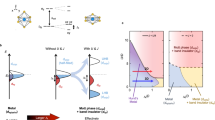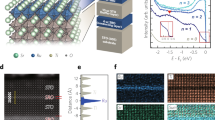Abstract
The occupation of d orbitals controls the magnitude and anisotropy of the inter-atomic electron transfer in transition-metal oxides and hence exerts a key influence on their chemical bonding and physical properties1. Atomic-scale modulations of the orbital occupation at surfaces and interfaces are believed to be responsible for massive variations of the magnetic and transport properties2,3,4,5,6,7,8, but could not thus far be probed in a quantitative manner9,10,11. Here we show that it is possible to derive quantitative, spatially resolved orbital polarization profiles from soft-X-ray reflectivity data, without resorting to model calculations. We demonstrate that the method is sensitive enough to resolve differences of ∼3% in the occupation of Ni eg orbitals in adjacent atomic layers of a LaNiO3–LaAlO3 superlattice, in good agreement with ab initio electronic-structure calculations. The possibility to quantitatively correlate theory and experiment on the atomic scale opens up many new perspectives for orbital physics in transition-metal oxides.
This is a preview of subscription content, access via your institution
Access options
Subscribe to this journal
Receive 12 print issues and online access
$259.00 per year
only $21.58 per issue
Buy this article
- Purchase on Springer Link
- Instant access to full article PDF
Prices may be subject to local taxes which are calculated during checkout




Similar content being viewed by others
References
Tokura, Y. & Nagaosa, N. Orbital physics in transition-metal oxides. Science 288, 462–468 (2000).
Chakhalian, J. et al. Orbital reconstruction and covalent bonding at an oxide interface. Science 318, 1114–1117 (2007).
Rata, A. D. et al. Strain-induced insulator state and giant gauge factor of La0.7Sr0.3CoO3 films. Phys. Rev. Lett. 100, 076401 (2008).
Jackeli, G. & Khaliullin, G. Spin, charge, and orbital order at the interface between correlated oxides. Phys. Rev. Lett. 101, 216804 (2008).
Tebano, A. et al. Evidence of orbital reconstruction at interfaces in ultrathin La0.67Sr0.33MnO3 films. Phys. Rev. Lett. 100, 137401 (2008).
Aruta, C. et al. Orbital occupation, atomic moments, and magnetic ordering at interfaces of manganite thin films. Phys. Rev. B 80, 014431 (2009).
Salluzzo, M. et al. Orbital reconstruction and the two-dimensional electron gas at the LaAlO3/SrTiO3 interface. Phys. Rev. Lett. 102, 166804 (2009).
Yu, P. et al. Interface ferromagnetism and orbital reconstruction in BiFeO3–La0.67Sr0.33MnO3 heterostructures. Phys. Rev. Lett. 105, 027201 (2010).
Schlappa, J. et al. Direct observation of t2g orbital ordering in magnetite. Phys. Rev. Lett. 100, 026406 (2008).
Thomas, K. J. et al. Soft X-ray resonant diffraction study of magnetic and orbital correlations in a manganite near half doping. Phys. Rev. Lett. 92, 237204 (2004).
Wilkins, S. B. et al. Direct observation of orbital ordering in La0.5Sr1.5MnO4 using soft X-ray diffraction. Phys. Rev. Lett. 91, 167205 (2003).
Muller, D. A. Structure and bonding at the atomic scale by scanning transmission electron microscopy. Nature Mater. 8, 263–270 (2009).
Smadici, S. et al. Superconducting transition at 38 K in insulating-overdoped La2CuO4–La1.64Sr0.36CuO4 superlattices: Evidence for interface electronic redistribution from resonant soft X-ray scattering. Phys. Rev. Lett. 102, 107004 (2009).
Stöhr, J. & Siegmann, H. C. Magnetism. From Fundamentals to Nanoscale Dynamics (Springer, 2007).
Mannhart, J. & Schlom, D. G. Oxide interfaces—an opportunity for electronics. Science 327, 1607–1611 (2010).
Chaloupka, J. & Khaliullin, G. Orbital order and possible superconductivity in LaNiO3/LaMO3 superlattices. Phys. Rev. Lett. 100, 016404 (2008).
Hansmann, P. et al. Turning a nickelate Fermi surface into a cupratelike one through heterostructuring. Phys. Rev. Lett. 103, 016401 (2009).
Han, M. J., Marianetti, C. A. & Millis, A. J. Chemical control of orbital polarization in artificially structured transition-metal oxides: La2NiXO6 (X=B, Al, Ga, In) from first principles. Phys. Rev. B 82, 134408 (2010).
May, S. J., Santos, T. S. & Bhattacharya, A. Onset of metallic behaviour in strained (LaNiO3)n/(SrMnO3)2 superlattices. Phys. Rev. B 79, 115127 (2009).
Liu, J. et al. Effect of polar discontinuity on the growth of LaNiO3/LaAlO3 superlattices. Appl. Phys. Lett. 96, 133111 (2010).
Macke, S., Brück, S. & Goering, E. ReMagX X-ray magnetic reflectivity tool, www.mf.mpg.de/remagx.html.
Parratt, L. G. Surface studies of solids by total reflection of X-rays. Phys. Rev. 95, 359–369 (1954).
Thole, B. T. & van der Laan, G. Sum rules for magnetic dichroism in rare earth 4f photoemission. Phys. Rev. Lett. 70, 2499–2502 (1993).
van der Laan, G. Sum rules and fundamental spectra of magnetic X-ray dichroism in crystal field symmetry. J. Phys. Soc. Jpn. 63, 2393–2400 (1994).
Schüßler-Langeheine, C. et al. Spectroscopy of stripe order in La1.8Sr0.2NiO4 using resonant soft X-ray diffraction. Phys. Rev. Lett. 95, 156402 (2005).
Višňovský, Š. Magneto-optical polar Kerr effect and birefringence in magnetic crystals of orthorhombic symmetry. Czech. J. Phys. B 34, 155–162 (1984).
Brück, S., Bauknecht, S., Ludescher, B., Goering, E. & Schütz, G. An advanced magnetic reflectometer. Rev. Sci. Instrum. 79, 083109 (2008).
Wu, W. B. et al. Orbital polarization of LaSrMnO4 studied by soft X-ray linear dichroism. J. Electron Spectroscopy 137–140, 641–645 (2004).
Blöchl, P. E. Projector augmented-wave method. Phys. Rev. B 50, 17953–17979 (1994).
Kresse, G. & Joubert, D. From ultrasoft pseudopotentials to the projector augmented-wave method. Phys. Rev. B 59, 1758–1775 (1999).
Perdew, J. P., Burke, K. & Ernzerhof, M. Generalized gradient approximation made simple. Phys. Rev. Lett. 77, 3865–3868 (1996).
Perdew, J. P., Burke, K. & Ernzerhof, M. Erratum: Generalized gradient approximation made simple. Phys. Rev. Lett. 77, 3865 (1996); Phys. Rev. Lett. 78, 1396 (1997).
Kresse, G. & Hafner, J. Ab initio molecular-dynamics simulation of the liquid-metal–amorphous-semiconductor transition in germanium. Phys. Rev. B 49, 14251–14269 (1994).
Kresse, G. & Furthmüller, J. Efficient iterative schemes for ab initio total-energy calculations using a plane-wave basis set. Phys. Rev. B 54, 11169–11186 (1996).
Acknowledgements
We acknowledge financial support from the Deutsche Forschungsgemeinschaft within the framework of the TRR80, project C1. The authors thank G. Khaliullin, V. Kiryukhin, and G. A. Sawatzky for discussions. We acknowledge the provision of synchrotron radiation and the assistance from W. Mahler and B. Zada at the UE562-PGM1 beamline at Helmholtz-Zentrum Berlin—BESSY II. We thank M. Dudek for making the hard-X-ray reflectivity measurements, and S. Heinze for taking the atomic force microscopy image.
Author information
Authors and Affiliations
Contributions
E.B. carried out the experiments and analysed the data. M.W.H. made substantial contributions to the data analysis and carried out the cluster calculations. S.B. and E.G. designed and set the experiment up. S.B., E.G. and S.M. developed the analysis tool ReMagX. G.C. and H-U.H. grew the superlattices by pulsed laser deposition. A.F., E.B., A.V.B. and P.W. characterized the samples by high-resolution X-ray diffraction. X.Y. and O.K.A. carried out the LDA+U calculations. I.Z. and H.J.K. assisted in the experiments. V.H. worked on the data collection and analysis. E.B., M.W.H., V.H. and B.K. wrote the paper. V.H. and B.K. coordinated the project.
Corresponding authors
Ethics declarations
Competing interests
The authors declare no competing financial interests.
Supplementary information
Rights and permissions
About this article
Cite this article
Benckiser, E., Haverkort, M., Brück, S. et al. Orbital reflectometry of oxide heterostructures. Nature Mater 10, 189–193 (2011). https://doi.org/10.1038/nmat2958
Received:
Accepted:
Published:
Issue Date:
DOI: https://doi.org/10.1038/nmat2958
This article is cited by
-
Atomic scale interfacial magnetism and origin of metal-insulator transition in (LaNiO\(_3\))\(_n\)/(CaMnO\(_3\))\(_m\) superlattices: a first principles study
Scientific Reports (2023)
-
Designing and controlling the properties of transition metal oxide quantum materials
Nature Materials (2021)
-
Domain-wall engineering and topological defects in ferroelectric and ferroelastic materials
Nature Reviews Physics (2020)
-
Electronic structure of the parent compound of superconducting infinite-layer nickelates
Nature Materials (2020)
-
Design of Complex Oxide Interfaces by Oxide Molecular Beam Epitaxy
Journal of Superconductivity and Novel Magnetism (2020)



